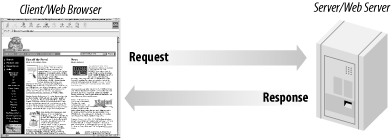Since the original version, HTTP/0.9, there have only been two revisions of the HTTP standard. HTTP/1.0 was released as RFC-1945[A] in May 1996 and HTTP/1.1 as RFC-2616 in June 1999.
[A] Request for Comments, or RFCs, are submitted to the RFC editor (http://www.rfc-editor.org) usually by authors attached to organizations such as the Internet Engineering Task Force (IETF athttp://www.ietf.org). RFCs date back to the early ARPAnet days and are used to present networking protocols, procedures, programs, and concepts. They also include meeting notes, opinions, bad poems, and other humor: RFC-2324 describes the Hypertext Coffee Pot Control Protocol.
Request and Response Model
HTTP is simple: a client-most conspicuously a web browser-sends a request for some resource to a HTTP server, and the server sends back a response. The HTTP response carries the resource-the HTML document or image or whatever-as its payload back to the client. This simple request-response model is shown in Figure B-2.
Figure B-2. Browser makes a request and the HTTP server responds

The term HTTP server is the correct description for what is more commonly called a web server. Technically, a web browser is an example of a user agent. Other user agents include proxy servers, applications that can provide services such as caching of responses, and access control.